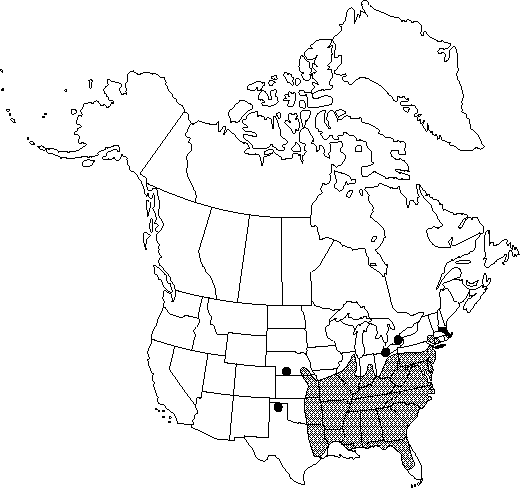Difference between revisions of "Clematis terniflora"
Syst. Nat. 1: 137. 1817.
FNA>Volume Importer |
FNA>Volume Importer |
||
| Line 30: | Line 30: | ||
}}<!-- | }}<!-- | ||
| − | --><span class="statement" id="st- | + | --><span class="statement" id="st-undefined" data-properties=""><b>Stems </b>climbing with tendril-like petioles and leaf rachises, 3-6 m. <b>Leaf</b> blade pinnately 3- or 5-foliolate; leaflets ovate or broadly lanceolate to narrowly deltate, to 6.5 × 3.5 cm, margins entire; surfaces abaxially glabrous or very sparingly appressed-strigose on major veins. <b>Inflorescences</b> axillary, 3-12-flowered cymes or compound cymes or paniculate with cymose subunits. <b>Flowers</b> bisexual, often some unisexual (staminate) in same inflorescence; pedicel 1-3.5 cm, slender; sepals wide-spreading, not recurved, white, linear or elliptic to lanceolate or narrowly obovate, 0.9-2.2 cm, length ca. 2-3 times width, abaxially tomentose along margins, adaxially glabrous; stamens ca. 50; filaments glabrous; staminodes absent; pistils 5-10. <b>Achenes</b> broad, flat, conspicuously rimmed, minutely appressed-silky, sometimes sparsely so; beak 2-6 cm.</span><!-- |
-->{{Treatment/Body | -->{{Treatment/Body | ||
| Line 36: | Line 36: | ||
|habitat=Roadsides, thickets, and other secondary sites, edges of woods near creeks | |habitat=Roadsides, thickets, and other secondary sites, edges of woods near creeks | ||
|elevation=0-1000 m | |elevation=0-1000 m | ||
| − | |distribution=Ont.;Ala.;Ark.;Conn.;Fla.;Ga.;Ill.;Ind.;Kans.;Ky.;La.;Md.;Mass.;Miss.;Mo.;Nebr.;N.H.;N.J.;N.Y.;N.C.;Ohio;Okla.;Pa.;S.C.;Tenn.;Tex.;Va.;W.Va.;native to Asia (China | + | |distribution=Ont.;Ala.;Ark.;Conn.;Fla.;Ga.;Ill.;Ind.;Kans.;Ky.;La.;Md.;Mass.;Miss.;Mo.;Nebr.;N.H.;N.J.;N.Y.;N.C.;Ohio;Okla.;Pa.;S.C.;Tenn.;Tex.;Va.;W.Va.;native to Asia (China;Korea;Japan). |
|discussion=<p>Clematis terniflora is commonly cultivated as an ornamental. It is widely naturalized in the eastern United States. The name C. paniculata J. F. Gmelin was incorrectly used for this species by Thunberg in 1794.</p><!-- | |discussion=<p>Clematis terniflora is commonly cultivated as an ornamental. It is widely naturalized in the eastern United States. The name C. paniculata J. F. Gmelin was incorrectly used for this species by Thunberg in 1794.</p><!-- | ||
--><p>Some authors have recognized two or more varieties in this species, correlated with their distribution in Asia, but in the study by H.Hara (1975), all of the varietal names were reduced to synonymy.</p> | --><p>Some authors have recognized two or more varieties in this species, correlated with their distribution in Asia, but in the study by H.Hara (1975), all of the varietal names were reduced to synonymy.</p> | ||
| Line 57: | Line 57: | ||
|habitat=Roadsides, thickets, and other secondary sites, edges of woods near creeks | |habitat=Roadsides, thickets, and other secondary sites, edges of woods near creeks | ||
|elevation=0-1000 m | |elevation=0-1000 m | ||
| − | |distribution=Ont.;Ala.;Ark.;Conn.;Fla.;Ga.;Ill.;Ind.;Kans.;Ky.;La.;Md.;Mass.;Miss.;Mo.;Nebr.;N.H.;N.J.;N.Y.;N.C.;Ohio;Okla.;Pa.;S.C.;Tenn.;Tex.;Va.;W.Va.;native to Asia (China | + | |distribution=Ont.;Ala.;Ark.;Conn.;Fla.;Ga.;Ill.;Ind.;Kans.;Ky.;La.;Md.;Mass.;Miss.;Mo.;Nebr.;N.H.;N.J.;N.Y.;N.C.;Ohio;Okla.;Pa.;S.C.;Tenn.;Tex.;Va.;W.Va.;native to Asia (China;Korea;Japan). |
|introduced=true | |introduced=true | ||
|reference=None | |reference=None | ||
| Line 63: | Line 63: | ||
|publication year=1817 | |publication year=1817 | ||
|special status=Introduced | |special status=Introduced | ||
| − | |source xml=https://jpend@bitbucket.org/aafc-mbb/fna- | + | |source xml=https://jpend@bitbucket.org/aafc-mbb/fna-data-curation.git/src/9216fc802291cd3df363fd52122300479582ede7/coarse_grained_fna_xml/V3/V3_826.xml |
|genus=Clematis | |genus=Clematis | ||
|subgenus=Clematis subg. Clematis | |subgenus=Clematis subg. Clematis | ||
|species=Clematis terniflora | |species=Clematis terniflora | ||
| − | |||
| − | |||
| − | |||
| − | |||
| − | |||
| − | |||
| − | |||
| − | |||
| − | |||
| − | |||
| − | |||
| − | |||
| − | |||
| − | |||
| − | |||
| − | |||
| − | |||
| − | |||
| − | |||
| − | |||
| − | |||
| − | |||
| − | |||
| − | |||
| − | |||
| − | |||
| − | |||
| − | |||
| − | |||
| − | |||
| − | |||
| − | |||
| − | |||
}}<!-- | }}<!-- | ||
-->[[Category:Treatment]][[Category:Clematis subg. Clematis]] | -->[[Category:Treatment]][[Category:Clematis subg. Clematis]] | ||
Revision as of 14:51, 27 July 2019
Stems climbing with tendril-like petioles and leaf rachises, 3-6 m. Leaf blade pinnately 3- or 5-foliolate; leaflets ovate or broadly lanceolate to narrowly deltate, to 6.5 × 3.5 cm, margins entire; surfaces abaxially glabrous or very sparingly appressed-strigose on major veins. Inflorescences axillary, 3-12-flowered cymes or compound cymes or paniculate with cymose subunits. Flowers bisexual, often some unisexual (staminate) in same inflorescence; pedicel 1-3.5 cm, slender; sepals wide-spreading, not recurved, white, linear or elliptic to lanceolate or narrowly obovate, 0.9-2.2 cm, length ca. 2-3 times width, abaxially tomentose along margins, adaxially glabrous; stamens ca. 50; filaments glabrous; staminodes absent; pistils 5-10. Achenes broad, flat, conspicuously rimmed, minutely appressed-silky, sometimes sparsely so; beak 2-6 cm.
Phenology: Flowering summer (Jul–Sep).
Habitat: Roadsides, thickets, and other secondary sites, edges of woods near creeks
Elevation: 0-1000 m
Distribution

Ont., Ala., Ark., Conn., Fla., Ga., Ill., Ind., Kans., Ky., La., Md., Mass., Miss., Mo., Nebr., N.H., N.J., N.Y., N.C., Ohio, Okla., Pa., S.C., Tenn., Tex., Va., W.Va., native to Asia (China, Korea, Japan).
Discussion
Clematis terniflora is commonly cultivated as an ornamental. It is widely naturalized in the eastern United States. The name C. paniculata J. F. Gmelin was incorrectly used for this species by Thunberg in 1794.
Some authors have recognized two or more varieties in this species, correlated with their distribution in Asia, but in the study by H.Hara (1975), all of the varietal names were reduced to synonymy.
Selected References
None.